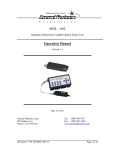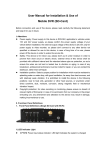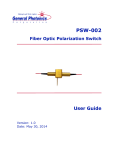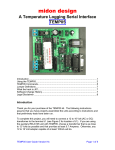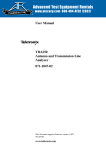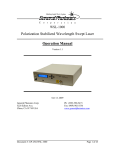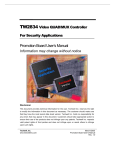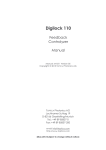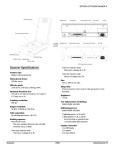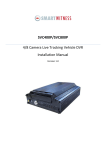Download FST-001-B User Manual V1.0c
Transcript
FST-001-B Fiber Stretcher Operation Manual April 6, 2005 General Photonics Corp. 5228 Edison Ave. Chino, CA 91710 USA Document #: GP-UM-FST-001-B-10 Ph: (909) 590-5473 Fax: (909) 902-5536 www.generalphotonics.com Page 1 of 9 Table of Contents: Caution 3 Section 1 Specifications 4 Section 2 Overview 5 Section 3 Operating Instructions 7 Section 4 Technical Support 9 Document #: GP-UM-FST-001-B-10 Page 2 of 9 IMPORTANT SAFETY NOTE The FST-001-B PCB board inside the enclosure can produce hazardous voltages and currents. The DC voltage on the board can reach 150 V. Never open the cover of the FST-001-B or touch any part of the board or cable connectors when electric power is on. CAUTION The maximum peak current to each channel of the FST-001-B is 60 mA. However, the maximum current available to each channel will depend on operating conditions. Because the on board DC/DC converter output current rating is 80 mA, the sum of the currents to the four channels cannot exceed 80 mA. If each channel is operated sequentially, the current limit per channel is 60 mA. However, if all 4 channels are in operation simultaneously, the maximum continuous operation current rating for the FST001-B is 20 mA per channel. A severely distorted output waveform indicates that the unit is being operated at a current that exceeds the current rating. If a sinusoidal waveform is used as a driving source, the user should check Section 3.2.1 in this manual to make sure that the output voltage and driving frequency are within the designed safe operation range. Document #: GP-UM-FST-001-B-10 Page 3 of 9 Section 1. Specifications: Physical Features: External analog input connector External digital input connector 10-pin AMP type with 0.1” pitch 20-pin AMP type with 0.1” pitch Max Ratings: Max. output voltage Max. output current Max Input Signal Voltage 140 VDC 20 mA/channel all channels (continuous) 60 mA/channel single channel (continuous) 60 mA per channel (peak current limit) 5V Optical Characteristics: Operating wavelength System insertion loss1 PDL Optical power handling Fiber Input/Output Connectors 1550 nm standard <0.2 dB <0.1 dB >1000 mW FC/PC, FC/APC, SC/PC, SC/APC2 Electrical Characteristics: Input Analog Signal Voltage Range Input Resistance Digital input 140V Output Response Time 15V Output Response Time Output Voltage Range Output Impedance External Input Gain Noise -3dB Bandwidth3 Operating Temp. Storage Temp. 0 to 5V ≥20 kΩ TTL, 12-bit data, 4-bit control < 400 µs rise/fall time 65 µs rise/fall time 0-140V DC 50 ohms 30 V/V ± 1% < 40 mV (RMS) 16 kHz 0 to 40º C -20 to 60º C Required Power Supply: Standard + 12V DC / 1.2A Note: 1. Measured without connectors. 2. Per customer specification. 3. The bandwidth is measured at 140V output with no load. Any piezoelectric element added to the output may decrease the bandwidth. The –3 dB bandwidth is defined by the frequency at which the output peak-to-peak voltage drops from 140 V to 100 V (~ 0.707 × 140 V). Document #: GP-UM-FST-001-B-10 Page 4 of 9 Section 2. Overview: The FST-001-B is a precision multiple channel fiber stretcher with four piezoelectric actuators that can be driven individually for high resolution or collectively for large stroke. Stretching the fiber causes a change in both the length and index of refraction of the fiber, resulting in a change in optical path length. Sample applications include optical path length compensation and various sensing and interferometric applications, including medical imaging. The FST-001-B accepts both analog and digital control signals. It has a closed loop gain of 30V/V, so analog input voltages of 0-5V are sufficient to cover the full range of the stretcher. The external analog control voltage can be supplied by any stable voltage source, including function generators, DAC output, or DC power supplies. For digital control applications, the FST-001-B can be controlled by a 16-bit parallel TTL digital signal from any logic circuit. The digital signal controls each channel individually. The standard board of the FST-001-B operates at +12V. A 12V power adapter that plugs into a standard wall power supply is provided. 2.1 Interface descriptions Analog and digital input connectors are mounted on the rear panel of the FST-001-B, as shown in Figure 1. The analog and digital input connectors are a 10-pin and a 20-pin AMP type, respectively. All connectors on the FST-001-B have standard 0.10 inch (2.54 mm) pin separation. The pinout diagram is shown in Figure 1. TTL Input 19 17 15 13 11 9 7 Analog Input 5 3 1 20 18 16 14 12 10 8 6 4 2 9 7 5 3 1 10 8 6 4 2 Figure 1 Analog and digital input connector configurations. The pin assignments for analog and digital input connectors are summarized in Table 1 and Table 2, respectively. The analog input connector uses 5 independent connections, while the digital connector has 18 independent connections. Document #: GP-UM-FST-001-B-10 Page 5 of 9 Table 1: Analog input connector pin assignment list Pin number 1 2 3 4 5 6 7 8 9 10 Assignment VIN1 VIN3 AGND AGND VIN2 VIN4 AGND AGND AGND AGND Function Channel 1 input Channel 3 input Analog ground Analog ground Channel 2 input Channel 4 input Analog ground Analog ground Analog ground Analog ground Table 2: Pin assignment for digital input connector Pin number 1 2 3 4 5 6 Assignment /WR /CS NC A0 A1 DB0 7 8 9 10 11 12 13 14 15 16 17 DB1 DB2 DB3 DB4 DB5 DB6 DB7 DB8 DB9 DB10 DB11 18 19 20 DGND DGND NC Document #: GP-UM-FST-001-B-10 Function Read/Write Chip select, negative active Not connected Channel control bit 1 Channel control bit 2 Digital signal least significant bit (LSB) Digital signal bit 2 Digital signal bit 3 Digital signal bit 4 Digital signal bit 5 Digital signal bit 6 Digital signal bit 7 Digital signal bit 8 Digital signal bit 9 Digital signal bit 10 Digital signal bit 11 Digital signal most significant bit (MSB) Digital ground Digital ground Not connected Page 6 of 9 Section 3. Operation Instructions: Important Safety Notes The FST-001-B PCB board inside the enclosure can produce hazardous voltages and currents. The DC voltage on the board can reach 150 V. Never open the cover of the FST-001-B or touch any part of the board or cable connectors when electric power is on. 3.1 Getting started Unpacking The FST-001-B is shipped with a [email protected] AC/DC power supply, analog and digital input cables, and user manual. Initial setup 1. 2. 3. Plug in +12V DC power supply on the rear panel. Connect analog or digital input cable to the appropriate analog or digital control signal source before connecting analog or digital input connectors to the FST-001-B. Connect input and output fibers to FST-001-B. It is important to clean the fiber connectors using industry standard procedures before connecting them. In the case of a high power laser source, turn off optical power source before connector cleaning. Note: For interferometric applications, make sure that all fibers are fixed in position and cannot move during measurement. This can be done by taping them to the optical table. 3.2 Operation The FST-001-B board can be operated under either analog or digital control modes. These two modes cannot be operated at the same time unless one of the control signal groups is set to zero. 3.2.1 Analog control mode operation To operate the FST-001-B in analog control mode, a multi-channel (at least 4 channels) DC or AC signal generator is required. Typical signal sources are function generators, DC power supplies, digital-analog-converter output lines, computer controlled analog output boards, etc. Analog signals can be applied to all channels simultaneously. 1. 2. Set the analog signal source at or near zero or its lowest output level. Connect analog signal source to analog input connector on the rear panel (use 10-pin input connector cable; refer to Figure 1 for pinout diagram). Turn on the +12V DC power supply (power switch on front panel). Document #: GP-UM-FST-001-B-10 Page 7 of 9 3. 4. Adjust voltage applied to the analog input connector to set voltage at the desired level. The input analog signals are amplified by a factor of 30. Never apply a voltage higher than 5V to the FST-001-B. Do not apply a negative input voltage to the FST-001-B. In general, the +12V current should be less than 1.0 A during continuous drive operation. If a function generator is used, make sure that the applied signal frequency and amplitude do not overload the circuit. To avoid damage to the amplifier board, periodic analog inputs (such as from a function generator) should meet the following conditions: a. For one channel operating alone, or for two channels (channels 1 and 3 or 2 and 4) operating simultaneously, input conditions must satisfy: BW = f * V < 2.5 kHz · V. For example, if peak-to-peak input voltage V = 2V, input frequency f must be < 1.25 kHz b. For three or 4 channels operating simultaneously, or if channels 1 and 2 or 3 and 4 are operating simultaneously, input conditions must satisfy: BW = f * V < 1.25 kHz · V. For example, if peak-to-peak input voltage V = 2V, input frequency f must be < 0.625 kHz. 5. 3.2.2 Turn off the power supply when not in use. Digital control mode operation Unlike the analog control mode, the digital control signals operate sequentially. The digital control signal is applied to one channel at a time. Of the 20 digital control signal lines, 17 are used for digital control signals, as listed in Table 2. Of the 17 control signals, 12 lines are used to load a 12-bit parallel voltage level control signal to a selected channel. The other 5 lines are used for data traffic control. Therefore, a parallel output signal source such as a digital input/output (DIO) board or computer parallel port is required to perform digital control. An initialization step is required when starting digital control mode operation. 1. 2. 3. 4. 5. Connect digital input connector to FST-001-B after initial setup steps. Turn on +12V DC power supply (power switch on front panel). Launch an application program that generates appropriate digital control signals. An initialization step is required at the beginning of digital control. The initialization process sets the following lines: W/R change from 0-1-0-1 DB0—DB11 from 0-1-0 A0, A1 from 0-1-0 CS from 0-1-0-1 The initialization process can be performed in parallel. Digital control of output voltages: a. Change W/R from 1 (default) to 0 (load data mode). Document #: GP-UM-FST-001-B-10 Page 8 of 9 b. Load data to DB0-DB11. c. Set A1, A0 to select output channel according to Table 6. Table 6: Output channel selection control assignment Channel 1 2 3 4 A1 0 0 1 1 A0 0 1 0 1 d. Change /CS (chip select) from 1 (default) to 0 (select chip) and back to 1 again. This feature is very useful when multiple FST-001-B units are in use. The user can apply the /CS signal to select different boards and to share the data lines. e. Maintain W/R at 0 and repeat steps (b) to (d) to operate another output channel. f. If reset is needed, change /Reset to 1. g. Turn off power supply when finished. Section 4. Technical Support: The FST-001-B can be serviced only by manufacturer authorized personnel. There are no user serviceable components in this system. General Photonics is committed to high quality standards and customer satisfaction. For any questions regarding the quality and the use of the FST-001-B, or future suggestions, please contact General Photonics Corporation at (909)-590-5473 (telephone) or (909)902-5536 (fax), or by e-mail at [email protected]. General Photonics will respond to all customer questions within 24 hours during regular business hours. You can also write to: General Photonics 5228 Edison Avenue Chino, California 91710 USA Document #: GP-UM-FST-001-B-10 Page 9 of 9









